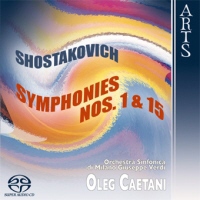

 |
 |
|
|
SHOSTAKOVICH: SYMPHONIES 1 &
 15 15
Dimitri Shostakovich (1906-75) Conductor: Oleg Caetini
SYMPHONY No 1 One way to sift out the differences between performances is simply to listen in as perfect a setting as possible for me, headphones and no interference from anywhere else. Then just sit back (or lie back) and watch out for things to happen.
On this new super audio disc from ARTS the first thing to notice is the depth of sound and separation of instruments cellos on the right by the way. The sonic spread is wonderful.
The opening of the First Symphony is given a swift and brilliant treatment and is played by an obviously brilliant Italian orchestra. All departments give marvellous accounts of themselves the right sort of perkiness in the woodwind, biting strings and rasping brass brilliantly underlining everything. The scherzo follows and the orchestra is joined by an orchestral piano that simply glitters.
Between movements 2 and 3 audience noise is heard for the first time. I checked with the jewel case Live Recording it says; well, I hadn't realised that until then. The slow movement begins well, with the wonderful cello solo sung' with passion and beauty. The violins en masse then play a rising theme against throbbing horns as the music swells with what I have always felt to be dark winter music. Always pressing on, the tempi here might seem a little too quick for Adagio but the observance of detail is thrilling. The solo violin passage is played as sweetly as any I have heard and the yearning is constant. The pace is picked up a little at the tutti following the trumpet's announcement before settling back to the original tempo.
Some may prefer a slower pace in this piece rather more hushed string chords before the rapid passage where the whole orchestra enters turmoil at the start of the finale which is played without a break. Again, all solos seem to be playing their parts to the manner born it is hard to think that this is not a Russian orchestra in fact.
The great climax on timpani solo heralds the coda and once more the principal cello soliloquises before the timpani rhythm is echoed on a pair of flutes and the full orchestra then sweeps along carrying everything before it. A new symphony has been born the new composer of it is only nineteen and already writing like a master. This amazing work has just received a performance equal to any.
Perky. That's the word to describe the opening of the Fifteenth Symphony. A perky little tune on the flute accompanied by a triangle then pizzicato strings. Followed by similar material played on the bassoon, the movement gets under way in a very jaunty style.
When I first heard this somewhat perplexing piece, my immediate reaction was to nickname it the quotation symphony. In this work he quotes from many things; Rossini's William Tell Overture as well as from his own music the first, seventh and eleventh symphonies alongside (almost) quotes from Wagner's Death of Siegfried' from Gotterdammerung and also Tristan und Isolde. He also uses the song by Glinka Do not tempt me needlessly' and the work closes with hints of this in its final utterances.
As with the First Symphony, Caetini makes a terrific argument for this Symphony to be at last taken seriously. He and his musicians give as fine a performance as I have ever heard and this includes that by Maxim Shostakovich (composer's son) who first premiered the work.
The core of this Symphony is in the great Adagio (second movement) and if the listener ever fancied living under a regime similar to that of 1984 (Orwell) then hearing this music could well convince him/her not to. A sardonic scherzo follows without a break and we are back in the world of wizardry and laughing with a sneer. This orchestra's wonderful basses and cellos are so strong, I should love to hear them in the Eleventh.
To my joy, on looking at the sleeve-note after writing this review, I see that the following recordings are also available from this team: Symphonies 5 & 6; 7; 4; 9 &10; 11; and finally 8. I have no doubt the others are in preparation. One error to note: both the booklet and the back cover describe the first and second movements of the Fifteenth Symphony in reverse but any listener will soon realise this.
Dennis Day |